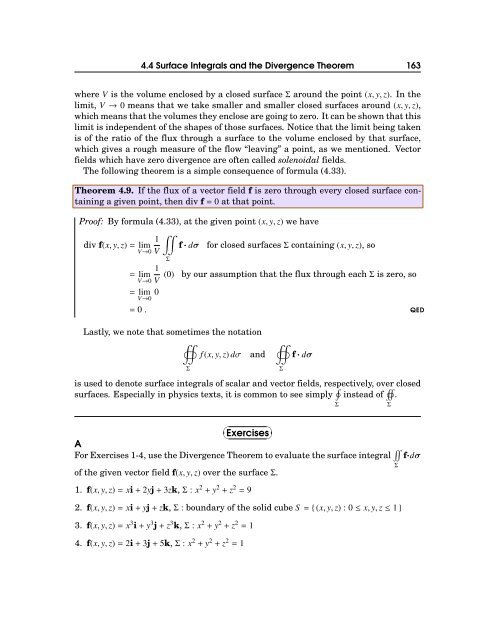Michael Corral: Vector Calculus
Michael Corral: Vector Calculus
Michael Corral: Vector Calculus
Create successful ePaper yourself
Turn your PDF publications into a flip-book with our unique Google optimized e-Paper software.
4.4 Surface Integrals and the Divergence Theorem 163<br />
where V is the volume enclosed by a closed surfaceΣaround the point (x,y,z). In the<br />
limit, V→ 0 means that we take smaller and smaller closed surfaces around (x,y,z),<br />
whichmeansthatthevolumestheyenclosearegoingtozero. Itcanbeshownthatthis<br />
limit is independent of the shapes of those surfaces. Notice that the limit being taken<br />
is of the ratio of the flux through a surface to the volume enclosed by that surface,<br />
which gives a rough measure of the flow “leaving” a point, as we mentioned. <strong>Vector</strong><br />
fields which have zero divergence are often called solenoidal fields.<br />
The following theorem is a simple consequence of formula (4.33).<br />
Theorem 4.9. If the flux of a vector field f is zero through every closed surface containing<br />
a given point, then div f=0at that point.<br />
Proof: By formula (4.33), at the given point (x,y,z) we have<br />
<br />
1<br />
div f(x,y,z)= lim f·dσ for closed surfacesΣcontaining (x,y,z), so<br />
V→0 V<br />
Σ<br />
1<br />
= lim (0) by our assumption that the flux through eachΣis zero, so<br />
V→0 V<br />
= lim 0<br />
V→0<br />
= 0. QED<br />
Lastly, we note that sometimes the notation<br />
<br />
f(x,y,z)dσ and<br />
Σ<br />
<br />
Σ<br />
f·dσ<br />
is used to denote surface integrals of scalar and vector fields, respectively, over closed<br />
surfaces. Especially in physics texts, it is common to see simply ∮ instead of .<br />
Σ Σ<br />
☛ ✟<br />
✡Exercises<br />
✠<br />
A<br />
ForExercises1-4,usetheDivergenceTheoremtoevaluatethesurfaceintegral Σ<br />
f·dσ<br />
of the given vector field f(x,y,z) over the surfaceΣ.<br />
1. f(x,y,z)= xi+2yj+3zk,Σ: x 2 +y 2 +z 2 = 9<br />
2. f(x,y,z)= xi+yj+zk,Σ:boundary of the solid cube S={(x,y,z) : 0≤ x,y,z≤1}<br />
3. f(x,y,z)= x 3 i+y 3 j+z 3 k,Σ: x 2 +y 2 +z 2 = 1<br />
4. f(x,y,z)=2i+3j+5k,Σ: x 2 +y 2 +z 2 = 1








